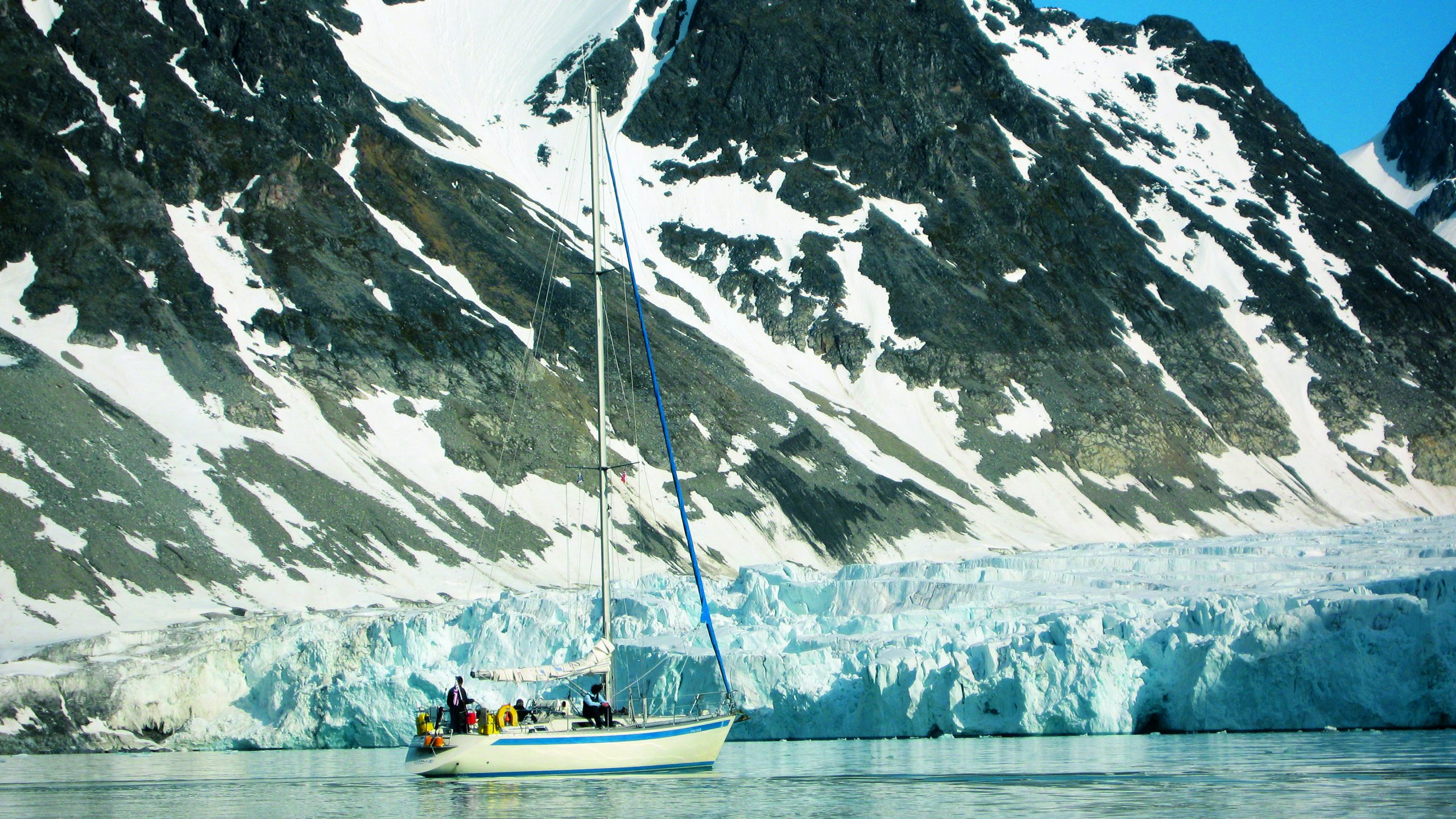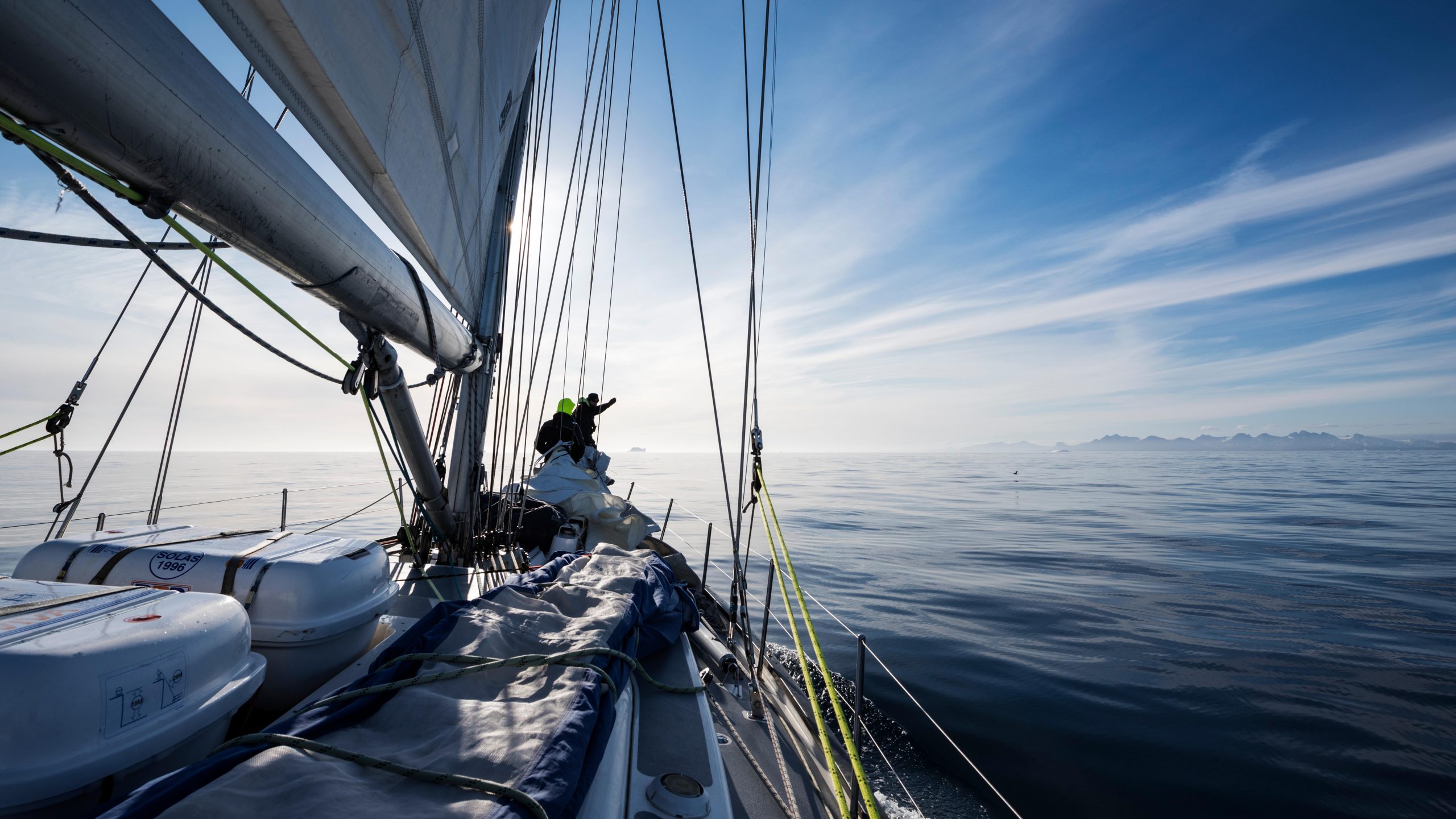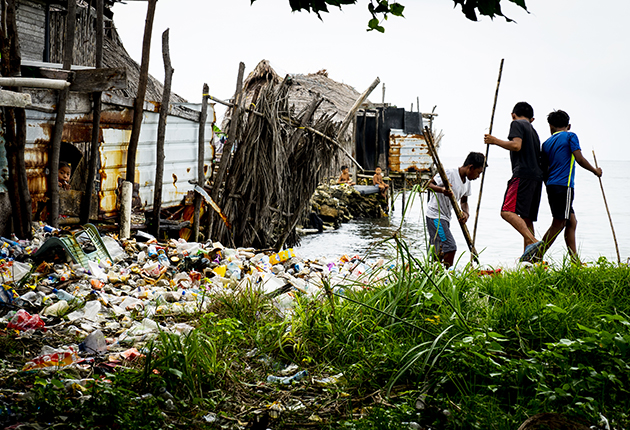Jon Amtrup and his crew sail to Bear Island in the Barents Sea on a mission to banish plastic from this Arctic wilderness. His article was runner-up in the 2021 Brian Black Memorial Award
Grey and barren, Bear Island appeared on the horizon, jumping out of the Barents Sea.
The almost heart-shaped rock, part of the Svalbard archipelago, lies at 74° north, and was discovered by the Dutch cartographer and polar explorer, Willem Barentsz.
When he and Jacob van Heemskerck approached the little island on 10 June 1596, a polar bear swam past them.
They were discoverers, seized the moment and named the jagged rock Bear Island, known as Bjørnøya in Norwegian.
No polar bear swam past us as we sailed towards the island’s southern tip.

Yachts need plenty of lines to anchor securely at Bear Island. Credit: Jon Amtrup
The chance of seeing a polar bear in summertime is sadly very rare these days. Climate change has made sure of it.
Nonetheless, all visitors must be armed with a gun, and know how to use it at all times when on shore.
We had sailed 500 miles from Tromsø in Norway to Bear Island, waiting a few hours in Vanvåg, one of the last ports on mainland Norway, before sailing into the Barents Sea.
Our Jan Kiærulf-designed custom-built 45ft aluminium expedition sailing boat, Njord, was carrying a crew of five; the course was due north and the wind was favourable from the south-west.
As soon as mainland Norway disappeared from the horizon behind us, a huge pod of dolphins joined us. Life on board was easy.
We did solo watches: two hours behind the wheel, eight hours off. We would arrive at Bear Island very well rested.
Plastic on Bear Island
The Arctic is under pressure. Plastic is everywhere in the Svalbard area.
It has been found in the deep waters between Greenland and Svalbard, and in the water and on the seabed in the Barents Sea.
According to the Norwegian Polar Institute, it is estimated to be around 194 pieces of litter per km2.
The combined weight is reckoned to be 79,000 tonnes, mostly plastic. These numbers are very hard to fathom; in an ideal world the figure should be zero.

Arriving at Bear Island, 500 miles from the Norwegian mainland. Credit: Jon Amtrup
Overconsumption and the over-reliance on single-use plastic are just some of the problems.
As 70% of the Earth is ocean, it is inevitable that plastic that doesn’t end up in a functional waste management facility will eventually float and sink into the mighty blue.
The ‘out of sight, out of mind’ attitude when it comes to plastic and other harmful and toxic materials in our oceans can simply not continue.
It only pushes the problem on to the next generation.
Plastic does not magically disappear by itself. It fragments into microplastics and ends up in the ecosystem.
As sailors and ocean activists we wanted to make a difference and formed the non-profit Gate to the Arctic to show others the way.

The crew documented everything they found including dead birds, which they checked for plastic ingestion. Credit: Jon Amtrup
The voyage to Bear Island was the organisation’s pilot project.
We would clean the beaches and explore and take samples for scientific use.
If it all went well, we would return the following year with 14-20 young who can inspire and teach their own generation to protect this fragile ecosystem.
Storytelling, e-learning and science will be key elements to reach a global audience, as well as cooperation with scientists and other interested organisations and people.
Watched over by the gods
The midnight sun welcomed us as we backed Njord into our designated harbour for the stay.
Russehamna on the south-east side is protected from all directions except from the winds coming from the east and south-east.
Njord is the god of the sea and winds from Norse mythology, and we were hoping the boat’s namesake would watch over us.
We deployed the anchor with 50m of kedge as we backed into the preset stern lines; we had sent a party of two with the dinghy into the anchorage.
Then we rigged two lines to shore, and then 150m of line from a big driftwood buried in the rocks to the stern.

All the plastic rubbish was sorted and recorded on the Tableau database, allowing scientists to use it in their research. Credit: Jon Amtrup
Over 400m of rope, kedge, bolts and slings managed to hold us in place.
The sun was still shining and we cracked open a bottle when we were finally tied up. It is a good polar tradition to celebrate when anchored.
The polar explorers, hunters and gatherers have never needed much of an excuse to throw a party in the high north. Our surroundings were unreal.
Jagged rocks, open ocean in front of us and a flock of black-legged kittiwakes had finally silently accepted us joining them in Russehamna.
Misery mountain, 536 metres above sea level, watched over us, the little red hut on shore looked inviting, but we stayed put.

The route taken by Jon and his crew. Credit: Maxine Heath
It was almost like we didn’t dare to step ashore.
Would we find massive amounts of plastic? A polar bear lurking?
The party lasted until early morning. In a world where the sun never sets, watches have no function.
We had breakfast at 1300 and ate dinner around the campfire at midnight.
The beauty of Bear Island
An expedition to the high latitudes is sure to give you a new perspective on life.
You have limited resources. Water and diesel can not be refilled. Electricity is produced by diesel, sun and wind. So you have to watch your energy consumption too. T
he food you bring can possibly be supplemented with fish, and all your waste has to be brought back. You soon find out that your resources are limited.
You can’t just pop down to the store to buy butter.

When in the Arctic: Hans Martin Halvorsen (from left), Catharina Frostad, Jon Amtrup, Shannon Nagy and Syver Flem – the crew of the Jan Kiærulf-designed custom-built 45ft aluminium expedition sailing boat, Njord. Credit: Jon Amtrup
But you also find that you don’t need much to be comfortable, just warm and dry clothes as well as nurturing food and good company.
You also discover how much waste you produce. Most things are wrapped in single-use plastic.
Back on the mainland it, hopefully, all goes in the bin. Up in the high latitudes you have to keep hold of it and bring it back to shore.
The feeling of remoteness soon hit us. What at first glance seemed like a grey landscape changed as our eyes focussed on the terrain.
Continues below…
Brian Black Memorial Award 2022: £4,000 prize on offer for environmental journalism
Back for a second year, the Brian Black Memorial Award 2022 is inviting entries to celebrate the best writing about…
Sailing in the Arctic: how to cruise to the far north
Once you’ve experienced the beauty and peace of sailing in the Arctic, you’ll want to return again and again. Andrew…
Climate Change: Why plastic pollution is a red herring
Myriad environmental initiatives are all laudable but can create confusion at a time when unified action is urgently needed, Mike…
Sailing Svalbard: an Arctic education
Sam Shrives contends with sea ice and an amorous walrus during a three-month cruise from Norway across the Barents Sea…
Polluted Paradise: Brian Black Memorial Award winner for 2021
Sophie Dingwall sees firsthand the impact of plastic pollution on the Caribbean's population. Her article - Polluted Paradise - has…
Small colourful flowers seemingly grew out of rock, alongside moss with endless variations of green.
The grey rock wasn’t grey at all. It was golden, brown and green.
As we walked over to Kvalrossbukta we could hardly believe how fortunate we were to experience this.
The scenery was breathtaking. It just goes to show how important it is to say ‘yes’ when chances like this come your way. Saying ‘no’ gets you nowhere.
Day two arrived with a gale from the west. Our mooring lines held and we went fishing; 20 seconds after the hooks went in the water we had caught five cod, enough for two days’ dinner.

Bear Island has a manned met-station in the North. Everything else is wilderness. Credit: Jon Amtrup
The fishing grounds around Bear Island are nutrient rich which attracts plenty of fish, but we didn’t think catching dinner would be that quick!
While exploring the beach we found two dead seagulls.
One was taken by a polar fox, which probably buried it somewhere to be eaten later in the winter. The other we dissected, having carefully sharpened the knife.
We didn’t find any plastic in the bird’s stomach or oesophagus – a good thing.
We did collect a meat sample for analysis. We also took one of many water samples which will also be analysed for microplastics by our science partner, the Scripps Institution of Oceanography at UC San Diego in California.
Aiding the world’s scientists
As we collected the plastic from the beaches of Bear Island, we examined and scanned it to determine what kind of plastic we had found.
We tried to discover its origin, and if there was any text on it which might give us a clue.
All of the results were sent by satellite back to Eskelund Consulting Service, which was then added to the Tableau database.
All our findings are public through Tableau, and every scientist can use it in their research. If we are to save the oceans, we have to work together.
Day three we hiked for four hours to get to the other side of the island. Beaches facing south and south-west always collect more waste than in the north.

The dinghy was invaluable to reach the craggy, inhospitable shoreline. Credit: Jon Amtrup
The prevailing winds ensure it. The amount of plastic we found was way more than we could handle. Car tyres, fishing nets, buoys, cans and bottles.
We even found a sofa washed ashore, 240 miles from the nearest mainland.
Day four and it was time to sail back. We could, of course, have stayed for weeks and months – and I think everyone wanted to stay in a world where nature ruled.
No phones, no internet, no mile-long coffee menu to choose from. The only thing you had to do up here was to remember your gun and watch the weather.
We rigged down all the lines and motored out of Russehamna. But we had one more beach to clean.
We didn’t have to do it, but all of us wanted to prolong our stay.

Water samples were collected to determine the levels of microplastics in the water. Credit: Jon Amtrup
Anchoring up in Sørhamna I stayed aboard to make dinner and watch the boat. The other four headed into shore in the dinghy.
What looked like a clean beach from afar, wasn’t. It seldom is.
In the sand, the crew found thousands of broken pieces of fishing buoys.
We had no chance of picking it all up as there were layers upon layers of colourful plastic pieces. We would have to return with a bigger crew.
It was time to hoist sails. We did it in silence as we sailed past the high cliffs teeming with birdlife.
Soon we had the dolphins on our bow again. Two days and nights later we were back in Tromsø.
We didn’t step off the boat for hours. We all wanted to savour the moment and pretend we were still on our own in the wild ocean in a boat.

Jon Amtrup has been sailing and writing for most of his life. He has sailed the Norwegian coast several times during both the summer and winter, crossed the Atlantic twice, circumnavigated Svalbard, sailed in Greenland, and is living on his boat. He has also assisted several high-latitude sailing expeditions and has done a number of yacht deliveries. He has written High Latitude Sailing: Self-sufficient Sailing Techniques for Cold Waters and Winter Seasons, Sail to Svalbard and a number of other books. Jon is co-founder of the environmental ocean non-profit Gate to the Arctic, and a member of The Explorers Club. See www.explorenorth.no.
Brian Black Memorial Award sponsored by B&G

Brian Black, a television journalist and lifelong sailor and contributor to Yachting Monthly, was as passionate about the marine environment as he was eloquent in his writing and filmmaking about the crises facing fragile Arctic ecosystems.
His wife Lesley was a sailor and author in her own right, becoming Northern Ireland’s first female yacht club commodore.
As a memorial to Brian and Lesley Black, the Black family, in conjunction with YM, established an award to celebrate sailing adventures which shed a fresh light on marine environmental issues through inspiring journalism.
The award aims to recognise the very best writing about the marine environment that brings a new perspective to readers.

The award is sponsored by marine electronics company B&G, which recognises sustainability as one of the pillars of its multi-year strategy.
B&G’s sustainability agenda includes: removing all single- use plastics from its packaging and using only recyclable materials from this year; reducing company air travel by 90%; reducing paper used in their offices by 95%; and decreasing energy consumption for IT equipment from 305,000kWh to 250,000kWh.
It is also working with sister company C-Map to open up their BioBase platform, which processes, maps and stores spatial aquatic data free of charge to government bodies and research institutes, to support aquatic conservation. www.bandg.com
For more details on the Brian Black Memorial Award 2022 visit: www.yachtingmonthly.com/bbma2022
Enjoyed reading this article?
A subscription to Yachting Monthly magazine costs around 40% less than the cover price.
Print and digital editions are available through Magazines Direct – where you can also find the latest deals.
YM is packed with information to help you get the most from your time on the water.
-
-
- Take your seamanship to the next level with tips, advice and skills from our experts
- Impartial in-depth reviews of the latest yachts and equipment
- Cruising guides to help you reach those dream destinations
-
Follow us on Facebook, Twitter and Instagram.









